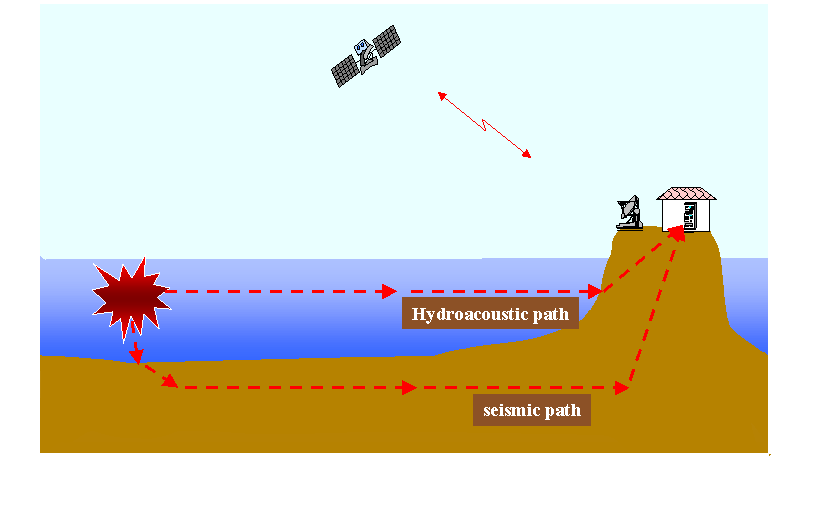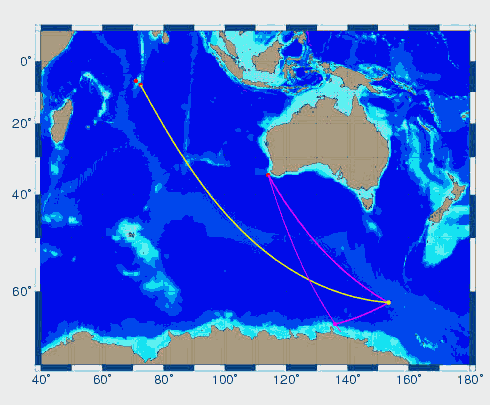Martin Lawrence - Martin.Lawrence@ctbto.org Popular version of paper 3pUWa2
Monitoring of Compliance with
the CTBT The Comprehensive Nuclear-Test-Ban
Treaty (CTBT) bans all nuclear explosion tests. The CTBT provides for verification
of compliance with the Treaty, by means of a global network of sensors. This
network, known as the International Monitoring System (IMS), is capable of detecting,
locating, and identifying signals generated by any nuclear explosion. Four different technologies are
being used for the IMS, allowing monitoring of tests conducted in any terrestrial
environment. Worldwide networks of sensors for each of the four technologies
are currently being deployed. The data from each station is transmitted in real
time to the CTBT headquarters in Vienna, Austria. The hydroacoustic network, discussed
here, monitors signals generated by an explosion located either in the ocean,
above the ocean but in the low atmosphere, or underground near the ocean shore.
Hydroacoustic Network The most effective way to monitor
underwater explosions is to make use of the exceptionally efficient transmission
of sound through the ocean. Because sound propagates over long distances in
the ocean, it is possible to design a global monitoring network to cover the
major world oceans, which only requires a small number of stations. When complete,
the eleven hydroacoustic stations will be located with an emphasis on the vast
ocean areas of the Southern Hemisphere. Each individual hydroacoustic station
comprises a number of sensing elements. This enables each station to have a
built-in direction finding capability. When combined with other stations, a
triangulation process allows for even better locating ability. The stations that make up the hydroacoustic
network consist of two different types. Six
stations are based upon hydrophone sensors. A hydrophone station, shown to the
right, is essentially an underwater microphone. Some key features for these
hydrophone-based stations are as follows. The stations will use hydrophones
in deep water, floated from the sea-floor to mid-water depth. A long cable (tens
to hundreds of kilometers) brings the signal back to a shore station. From here
the signal is sent by satellite to CTBT headquarters in Vienna. When these shore
stations are on small islands (which is the usual situation) there are hydrophones
deployed on opposite sides of the island, in order to prevent blocking of the
signal by the island. The hydrophone stations monitor at the low frequencies
(1 to 100 Hz) suitable for recording explosions at large distances. Implementation All of the eleven IMS hydroacoustic
stations are being built as new facilities for CTBT monitoring purposes. Although
there were pre-existing stations at three of the locations, the CTBT requirements
have necessitated the complete replacement of these stations. Prior to installation of a station,
a site survey is undertaken. The site survey determines such things, for a hydrophone-based
station, as where to best locate hydrophones and what is the optimum cable route.
The site survey program for the hydroacoustic network is essentially complete.
As of late 2002, there are three
complete and operational stations, two of these are hydrophone based and one
is a T-Phase station. Work has begun at all of the remaining stations. Several
are scheduled for completion during 2003, with the total network is expected
to be complete by the end of 2005. Operation of the stations to CTBT
standards leads to very high levels of data availability. The data from all
stations will be sent to the CTBT headquarters in real time, 24 hours per day
every day of the year. Although this network is being installed for monitoring
of nuclear explosions, it can in principle be expected to provide a unique resource
for scientific investigation of various ocean phenomena. Hydroacoustic Signals Signals recorded by the hydroacoustic
stations are caused by many different events. In the absence of signals from
nuclear tests, some of the strongest signals detected come from earthquakes
(including undersea earthquakes). The great sensitivity of the hydrophone-based
stations has even allowed clear detection of signals that are reflected off
continental boundaries. An example of such a reflected path that has been observed
in the data is shown here. The event generating the signal is located to the
right in the figure, marked with a yellow dot. Paths of detected signals are
shown, including one reflecting off Antarctica. Signals have been detected from
unexpected sources. Apparently, icebergs generate low frequency tones. The frequencies
are well below those than can be detected by human hearing. These iceberg generated
tones vary slowly in pitch and may last for several minutes. The location of
generation of the sounds has been correlated with the position of large icebergs.
The mechanism of production of the signal is not clear at the present time.
Whales and other biologic sources
of sound are detected on the hydroacoustic stations. The daily number of such
detections shows seasonal patterns, as the whales undertake their annual migration
cycle. These are just some of the many
sources of sound that lead to signals detected by this new global network.
Marta Galindo Arranz, Patrick Grenard, John Newton
Comprehensive Nuclear-Test-Ban Treaty Organization
Vienna International Centre
A-1400 Vienna, Austria
Mobile: +43-664 544 7327
Presented Wednesday afternoon, December 04, 2002
First Pan-American/Iberian Meeting on Acoustics, Cancun, Mexico
 A hydroacoustic network to monitor the major world oceans is being constructed
and operated. The development of this unique resource, which will be based on
eleven, widely separated stations, currently has three stations complete, with
work on the other eight in various stages of progress. Every station will be
operated continuously, into the indefinite future, with high levels of data
availability. Already, very interesting results are being observed on the completed
stations. The location of all eleven hydroacoustic stations comprising the IMS
hydroacoustic network is shown in the figure.
A hydroacoustic network to monitor the major world oceans is being constructed
and operated. The development of this unique resource, which will be based on
eleven, widely separated stations, currently has three stations complete, with
work on the other eight in various stages of progress. Every station will be
operated continuously, into the indefinite future, with high levels of data
availability. Already, very interesting results are being observed on the completed
stations. The location of all eleven hydroacoustic stations comprising the IMS
hydroacoustic network is shown in the figure.  The
characteristics of hydroacoustic signals are especially effective at identifying
the nature of the event that created the signal. This is very valuable, in particular,
in determining whether an event was an explosion or not.
The
characteristics of hydroacoustic signals are especially effective at identifying
the nature of the event that created the signal. This is very valuable, in particular,
in determining whether an event was an explosion or not.  The
other type of station used in the hydroacoustic network is based on use of seismometers
located on small islands, as shown in the figure to the left. These five hydroacoustic
stations, called T-phase stations, are located on steep-sloped islands in order
to make use of seismic equipment to detect hydroacoustic waves. A hydroacoustic
wave travelling through the water and striking the flank of the island is converted
to a seismic wave in the ground. These T-phase stations are significantly cheaper
than the hydrophone stations, but their performance is not as good (due to losses
and complexities in the conversion process). The make-up of the hydroacoustic
network is a balance between performance and cost.
The
other type of station used in the hydroacoustic network is based on use of seismometers
located on small islands, as shown in the figure to the left. These five hydroacoustic
stations, called T-phase stations, are located on steep-sloped islands in order
to make use of seismic equipment to detect hydroacoustic waves. A hydroacoustic
wave travelling through the water and striking the flank of the island is converted
to a seismic wave in the ground. These T-phase stations are significantly cheaper
than the hydrophone stations, but their performance is not as good (due to losses
and complexities in the conversion process). The make-up of the hydroacoustic
network is a balance between performance and cost.  During the time since completing the first stations, many interesting hydroacoustic
phenomena have been observed in the data.
During the time since completing the first stations, many interesting hydroacoustic
phenomena have been observed in the data.